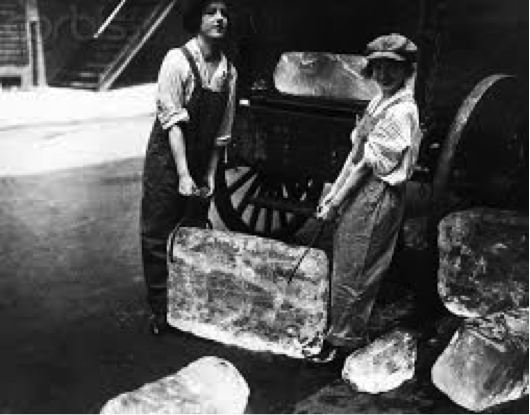Farm to table eating one hundred years ago quite literally meant, farm to table. During the first part of the 20th century, people picked, bought or grew their own food; keeping fresh food from spoiling was a daunting task without refrigeration.


In 1904 the first refrigerator made its debut at the St. Louis World fair, but was not mass-produced until 1927 by General Electric. According to U.S. Cooler,
“Refrigerators weren’t widely used. Even in the early 20th century, people usually had to get produce fresh daily and consume it almost as quickly. They made frequent trips to the butcher’s shop, and the milkman completed daily rounds. Fortunate people who had the money to spare for weekly ice deliveries were able to keep food for two or three days in an icebox.”
In today’s world, time is of the essence, especially when grocery shopping; you want to get in, get out and go on about your day. How often do you go food shopping with the intention of eating healthy meals, loading up your cart with fresh fruit and vegetables?
You come home and pack all that fresh, healthy food away, ready to start the week off right. One day turns into another; the produce starts to wilt as you grab lunch at work and dinner with friends. When you finally open your refrigerator craving for some vegetation, staring back at you is a bunch of produce that has seen better days.
Why do some foods go bad while others do not? How long can certain foods stay refrigerated and does it affect the nutrients?
Why Some Foods Go Bad Quicker
Some foods spoil more rapidly because of the bacteria that grows on it. The quicker the food wilts or browns will depend on how rapidly the bacteria reproduces in the temperature surrounding it. Bacteria will thrive in anything higher than 40 degrees; so make sure to check what your refrigerator is set at. Lower temperatures do not kill foreign invaders, but will definitely slow down their progress.
Not all bacteria are harmful and a brown spot here or there does not equate to ‘time to throw away’. For instance, the riper bananas become the higher the antioxidant levels are to help the immune system fight disease. The banana also produces a cancer fighting substance called TNF – Tumor Necrosis Factor, which gains in strength the longer it sits.
How long to keep Foods in the Refrigerator
When storing fresh foods follow guidelines provided by the FDA with food type and length of time to safely store. Some foods naturally spoil faster, like leafy greens. A good way to combat this is by taking a couple sheets of dampened paper towel and wrap around your greens; the moistness nourishes the leaves and allows them to breath. The worst thing to do is to keep vegetables in a closed, unventilated bag, this will only invite decay to happen faster.
Bay End Farms is a great resource for how to store fruit and vegetables properly and maximize the benefits.
How Does Refrigeration Affect the Nutrients
This question depends on a couple variables like, how long does it take between harvest and the length of time vegetation arrives on grocery shelves? How long then does it sit on shelves?
Once a fruit or vegetable is picked it starts to ripen, sometimes losing nutrients and sometimes gaining them. Since produce contains mostly water, water-soluble vitamins like C tend to degrade quicker and can lose a sizeable percentage of nutritional value by the time the produce is consumed. Vitamin C, thiamine & B6 are also very light sensitive, which can hasten the loss of nutrients.
Bacteria thrive at room temperature; refrigeration slows down the ‘breathing’ of foods allowing longer storage times.
According to UC Davis University, “harvest to shelf time can take anywhere from a few days to several weeks, depending on its mode of transit. Once fresh produce finds its way to the shelves it sits there usually 1-3 days, and then in your home for up to a week.”
This is one of the benefits for buying produce locally and supporting farmers markets; the transit time is much shorter than store bought, retaining more healthy nutrients.
The Heart Association offers information on what produce stores well together and what you should keep separate. There are some types of vegetation like apples, pears and green onions that emit ethylene as they ripen and should be stored separate from vegetation that does not like broccoli, leafy greens and blackberries.
Tips on Maximizing Nutritional Value
Fruits and vegetables are a living entity, so it is only natural that they will start to lose some of their nourishment after being picked.
- Eat your produce sooner than later
- Slicing into vegetation exposes their protective skin, degrading nutrients; so cut and eat
- Utilize and eat the skins, many of the vitamins are retained here
- Buy locally from farmer’s markets
- Purchase only what you plan to eat so you are throwing less spoiled food away















